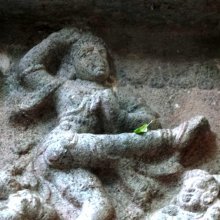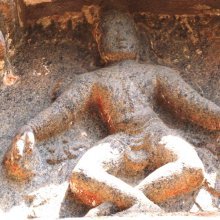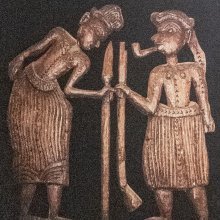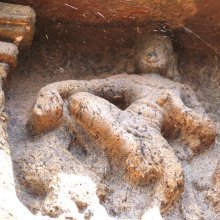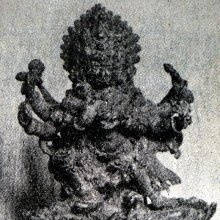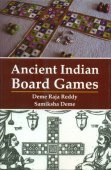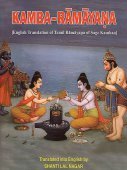Throwing: 1 definition
Introduction:
Throwing means something in Hinduism, Sanskrit. If you want to know the exact meaning, history, etymology or English translation of this term then check out the descriptions on this page. Add your comment or reference to a book if you want to contribute to this summary article.
Images (photo gallery)
In Hinduism
Natyashastra (theatrics and dramaturgy)
Source: Shodhganga: Elements of Art and Architecture in the Trtiyakhanda of the Visnudharmottarapurana (natya)(The act of) Throwing is associated with Niṣedhahasta: one of the thirteen Combined-hand Gestures (in Indian Dramas) (known as saṃyuktahastas), according to the Viṣṇudharmottarapurāṇa, an ancient Sanskrit text which (being encyclopedic in nature) deals with a variety of cultural topics such as arts, architecture, music, grammar and astronomy.—The word niṣedha means prohibition. In the niṣedha posture mukula hand covers the kapittha hand and this posture is used in reducing, throwing and pressing.

Natyashastra (नाट्यशास्त्र, nāṭyaśāstra) refers to both the ancient Indian tradition (shastra) of performing arts, (natya—theatrics, drama, dance, music), as well as the name of a Sanskrit work dealing with these subjects. It also teaches the rules for composing Dramatic plays (nataka), construction and performance of Theater, and Poetic works (kavya).
See also (Relevant definitions)
Query error!
Full-text (+733): Prakshepa, Vikshepa, Utkshepa, Nikshepa, Kshepana, Sankshepa, Kshepa, Prakshepana, Kshipana, Vikshepana, Nipatana, Paryasana, Kshipa, Abhyavaharana, Tepana, Vyudasa, Akshepa, Patana, Udirana, Samirana.
Relevant text
Search found 312 books and stories containing Throwing; (plurals include: Throwings). You can also click to the full overview containing English textual excerpts. Below are direct links for the most relevant articles:
Vaisheshika-sutra with Commentary (by Nandalal Sinha)
Sūtra 1.1.7 (Enumeration of Actions) < [Chapter 1 - Of Substance, Attribute, and Action]
Sūtra 1.1.29 (Above continued) < [Chapter 1 - Of Substance, Attribute, and Action]
Sūtra 5.1.11 (Non-volitional action, not a cause of virtue or vice) < [Chapter 1 - Of Voluntary Action]
Padarthadharmasamgraha and Nyayakandali (by Ganganatha Jha)
Text 144 < [Chapter 6a - On Actions]
Text 143 < [Chapter 6a - On Actions]
Text 140 < [Chapter 6a - On Actions]
Chaitanya Bhagavata (by Bhumipati Dāsa)
Verse 2.10.70-072 < [Chapter 10 - Conclusion of the Lord’s Mahā-prakāśa Pastimes]
Verse 3.1.15 < [Chapter 1 - Meeting Again at the House of Śrī Advaita Ācārya]
Verse 1.9.46 < [Chapter 9 - Nityānanda’s Childhood Pastimes and Travels to Holy Places]
Manusmriti with the Commentary of Medhatithi (by Ganganatha Jha)
Verse 4.151 < [Section XIV - Other Duties]
Verse 6.15 < [Section III - Details of the Hermit’s Life]
Verse 5.122 < [Section XIII - Purification of Substances]
Garga Samhita (English) (by Danavir Goswami)
Verse 2.4.16 < [Chapter 4 - The Liberation of Vatsāsura]
Verse 5.8.30 < [Chapter 8 - The Killing of Kaṃsa]
Verse 1.6.22 < [Chapter 6 - Description of Kaṃsa’s Strength]
Vinaya Pitaka (4): Parivara (by I. B. Horner)
Nuns’ Analysis: on Laying-Down-Where (Saṅghādisesa) < [2.9. Nuns’ Analysis: on Laying-Down-Where]
2.9. Nuns’ Analysis: on Laying-Down-Where
Nuns’ Analysis: on Laying-down-Where (Saṅghādisesa) < [2.1. Nuns’ Analysis: on Laying-down-Where]
Related products
